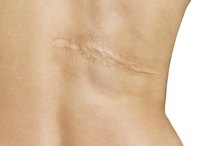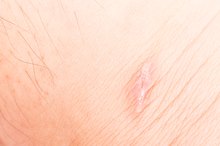What does fact checked mean?
At Healthfully, we strive to deliver objective content that is accurate and up-to-date. Our team periodically reviews articles in order to ensure content quality. The sources cited below consist of evidence from peer-reviewed journals, prominent medical organizations, academic associations, and government data.
The information contained on this site is for informational purposes only, and should not be used as a substitute for the advice of a professional health care provider. Please check with the appropriate physician regarding health questions and concerns. Although we strive to deliver accurate and up-to-date information, no guarantee to that effect is made.
Glycolic Acid & Keloids
Glycolic acid is one of the many alpha hydroxy acids used to improve the appearance of the skin. It's found in many facial cleansers and creams in fairly low concentrations to combat the common signs of aging. While it's known to reduce wrinkles, dryness and skin discolorations, glycolic acid isn't typically used to treat raised scars such as keloids. In fact, the irritation caused by this acidic agent could potentially lead to undesirable side effects, especially when applied in higher concentrations.
Glycolic Acid
Glycolic acid is often used in the mildest of chemical peels, according to the American Society of Plastic Surgeons. Only the very surface layer of the skin is removed during a glycolic peel, which can help to improve the appearance of wrinkles, dry skin, acne and uneven pigmentation. But with keloids, even in the highest of concentrations, glycolic acid can only really soften the raised scar tissue. It won't remove it.
- Glycolic acid is often used in the mildest of chemical peels, according to the American Society of Plastic Surgeons.
- Only the very surface layer of the skin is removed during a glycolic peel, which can help to improve the appearance of wrinkles, dry skin, acne and uneven pigmentation.
Skin Reactions
Chemical Peels for Scars
Learn More
Due to the unpredictable reaction of the skin to this acidic agent, using glycolic acid peels to improve keloids actually carry some risks. Though rare, chemical peels can lead to scarring. And since you have a history of keloids, you're more likely to develop another. The American Osteopathic College of Dermatology explains that keloids can arise from minor injuries to the skin 2. The irritation and subsequent blistering caused by a glycolic acid peel has the potential of worsening a preexisting keloid.
- Due to the unpredictable reaction of the skin to this acidic agent, using glycolic acid peels to improve keloids actually carry some risks.
Recommendations
Chemical peels using glycolic acid are far more appropriate in treating shallow scars, advises the American Academy of Dermatology 12. The formation of new skin cells caused by the peel can help smooth slight indentations with the surrounding skin, making the scar less noticeable than before. However, it may take a number of treatments to provide the desired results.
Improving Keloids
Skin Bleach for Scars
Learn More
Instead of using glycolic acid to improve the appearance of keloids, most medical professionals suggest intralesional injections of corticosteroids as a treatment. The American Academy of Dermatology states that they not only soften keloids, but also flatten the raised scar tissue with the rest of the skin 12.
Other Treatments
If corticosteroids fail to provide results, you can turn to other options, which often include:
- cryotherapy
- surgical removal
- laser therapy
- silicone gels
Actually, the American Academy of Dermatology advises the use of pulsed dye lasers 12. The laser energy helps to flatten the keloid as well as lighten any hyperpigmentation affecting the raised scar tissue.
Related Articles
References
- American Academy of Dermatology: Raised Acne Scars--Treatment Can Ease Pain, Diminish Scars
- American Academy of Dermatology: What is a Scar?
- National Institutes of Health: Keloids
- National Institutes of Health PubChem. Glycolic acid. Updated February 1, 2020.
- Tang SC, Yang JH. Dual effects of alpha-hydroxy acids on the skin. Molecules. 2018;23(4):863. doi:10.3390/molecules23040863
- Fabbrocini G, Annunziata MC, D'Arco V, et al. Acne scars: pathogenesis, classification and treatment. Dermatol Res Pract. 2010;2010:893080. doi:10.1155/2010/893080
- U.S. Food and Drug Administration. Alpha hydroxy acids. Updated May 7, 2019.
- Al-Talib H, Al-Khateeb A, Hameed A, Murugaiah C. Efficacy and safety of superficial chemical peeling in treatment of active acne vulgaris. An Bras Dermatol. 2017;92(2):212–216. doi:10.1590/abd1806-4841.20175273
- Abels C, Reich H, Knie U, Werdier D, Lemmnitz G. Significant improvement in mild acne following a twice daily application for 6 weeks of an acidic cleansing product (pH 4). Journal of Cosmetic Dermatology. 2014;13(2):103-8. doi:0.1111/jocd.12086
- Kaminaka C, Uede M, Matsunaka H, Furukawa F, Yamomoto Y. Clinical evaluation of glycolic acid chemical peeling in patients with acne vulgaris: a randomized, double-blind, placebo-controlled, split-face comparative study. Dermatological Surgery. 2014;40(3):314-22. doi:10.1111/dsu.12417
- Sharad J. Glycolic acid peel therapy - a current review. Clinical Cosmetic and Investigational Dermatology. 2013;6:281-8. doi:10.2147/CCID.S34029
- Takenaka Y, Hayashi N, Takeda M, Ashikaga S, Kawashima M. Glycolic acid chemical peeling improves inflammatory acne eruptions through its inhibitory and bactericidal effects on Propionibacterium acnes. Journal of Dermatology. 2012;39(4):350-4. doi:10.1111/j.1346-8138.2011.01321.x
Writer Bio
Based in Minneapolis, Minn., Dana Severson has been writing marketing materials for small-to-mid-sized businesses since 2005. Prior to this, Severson worked as a manager of business development for a marketing company, developing targeted marketing campaigns for Big G, Betty Crocker and Pillsbury, among others.









